Beverly Fishman’s artworks stand out for their vibrant and luminous colors, silky textures, and minimalist shapes. They create a sense of weightlessness with the infinite white, as objects floating on water, when hung on the white wall; and the neon colors break this psychological confusion, drawing out the social reality that Fishman reveals in her abstract expression. Fishman has always been fascinated by the pharmaceutical industry. She understands the importance of color psychology in pharmaceutical packaging design and matching, as evidenced by her work using high purity colors to demonstrate the market impact of human-designed drugs.
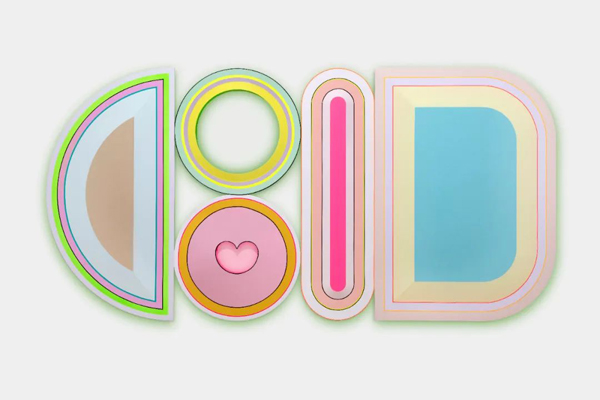
Beverly Fishman, Untitled (Pain, Pain, Anxiety, Pain, GERD), 2022, Urethane paint on wood, 48 x 96 inches. Photo: PD Rearick. Courtesy of Beverly Fishman
Correspondingly, the minimalist shapes of pills, tablets, and capsules take on an abstract language for Fishman. She performs visual analyses of the shapes of various drugs and dose sizes, such as pentagons, triangles, or squares, and presents them in modular combinations. The individual geometric shapes have an air of industrial precision, but are effectively sharpened in their arrangement and combination, that is, the sharp corners of some shapes are smoothed out. In the context of the real situation, this is a concession Fishman makes through art, or rather, a soft-landing artistic response to the social condition created by drugs. Fishman’s artistic language and visual expression could pertain to that of the artist Peter Halley, who explores social issues through large areas of neon colors, geometric shapes, and a minimalist artistic language.
In contrast to some of the other works named after illnesses, the two murals, “Recovery I” and “Recovery II”, commissioned by the Eli and Edythe Broad Art Museum, reveal positive overtones and a desire to seek a favorable turn in the present. These two works, which resemble five giant letters, are about drugs. Fishman meticulously designs them to fit the available space on the gallery wall. For instance, depending on the wall, the corners of the shapes are designed to be right-angled or rounded; the edge of the square runs parallel to the direction of the wall, which extends the depth of the physical space and visually cuts through the flat wall— if the wall is the two-dimensional plane, then this technique enriches the picture construction. The highly saturated colors in the work are reflected by the light and floor of the exhibition hall, rendering a sci-fi atmosphere. Through the dislocation and inversion of time and space, those small objects in the real world are turned into objects beyond their original size in the proper imagination. The structure, design, and texture of the objects can be observed and used to derive reflective information. This is also evident in her installation of hand-blown glass (Pill Spill).
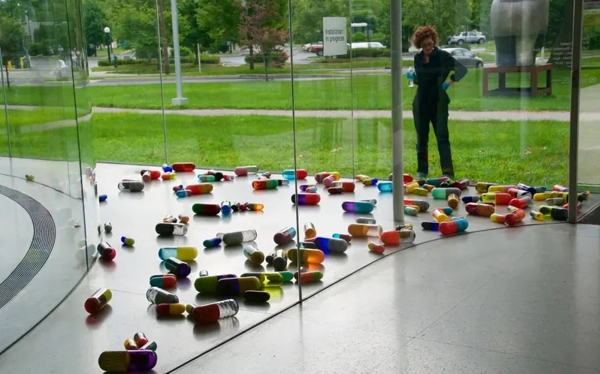
Beverly Fishman, Pill Spill. Toledo Museum of Art, Glass Pavilion, Toledo, OH, 2011. Photo: Matthew Biro. Courtesy of Beverly Fishman
Hu Lingyuan: I know you were recently selected by the Broad Art Museum to create a significant new work as part of the museum’s 10th anniversary celebration. This is the second time you've done a show here. Can you tell us a little about the two new works or this show? Is there any special design or meaning in the work or exhibition?
Beverly Fishman: The new works are 18 x 35 foot wall paintings that represent configurations of drugs. Many pharmaceuticals are scored so that you can take half or even a quarter dose, so each shape you see in my murals represents a pill fragment. Although the paintings look abstract, and I arrive at the combination of forms and colors intuitively, it is important to me that these compositions represent commercial medicines. The paintings are installed for six months, and then they will be painted over. The museum owns the design, which enables them to recreate the murals again at a later date. It was an exciting project, because it allowed me to engage with a visionary architect, Zaha Hadid, and the Broad’s two-story auditorium, with its twisting architecture and massive window. I thought a lot about that window, responding to its angularity with curved shapes and silver paint that would reflect the light.
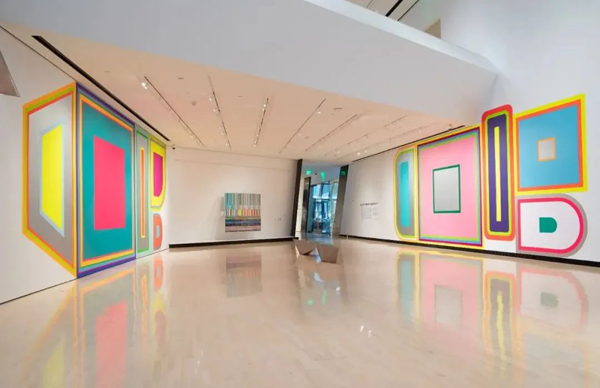
Beverly Fishman: Recovery, installation view at the Eli and Edythe Broad Art Museum at Michigan State University, 2022. Photo: Eat Pomegranate Photography. Courtesy of Beverly Fishman
Beverly Fishman: The two murals are named “Recovery #1 and #2,” but when I came up with that name about a year ago, I did not know if that would be true when the show opened. Now that the show has opened, I’m still not sure. I think things are getting better, and that the world is coming out of the pandemic at last, but for every two steps forward, we seem to have gone one step back. One thing is for sure, the COVID-19 has changed us tremendously. As an artist, I seek to affect my audiences on physical and emotional levels, but also to get them to reflect on the power that medicine holds in our lives. I think that everyone is aware of the power of medicine much more today than even three years ago.
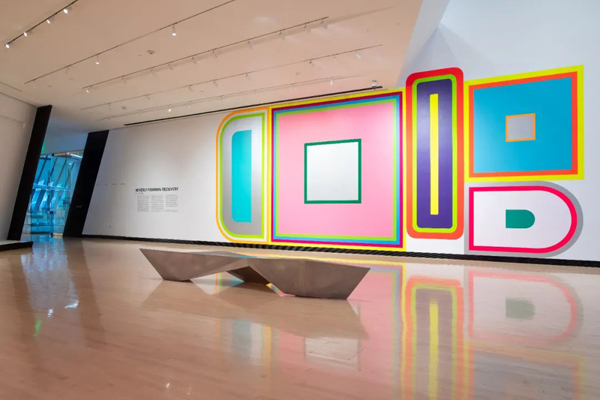
Beverly Fishman, Recovery II, installation view at the Eli and Edythe Broad Art Museum at Michigan State University, 2022. Photo: Eat Pomegranate Photography. Courtesy of Beverly Fishman
Hu Lingyuan: The works on display are depicted on the wall, right? I noticed that some of your works in Reliefs series where you created a space inside and glowed inside or at the edges. How do you interpret this hollow-out section or these spaces in your works?
Beverly Fishman: The large scale murals at the Broad are painted directly on the wall. There is an undercoat and then many layers of the same hue to create a uniform and saturated effect. Although my reliefs have a formal similarity to the “Recovery” murals they are very different as well. They are smaller and have cutout forms and beveled edges to engage the wall through reflected color. I think of the cutouts in the reliefs as representing missing doses of medicine; but I also employ them to remind viewers of the powers hidden beneath the surfaces of pills and tablets. On a formal level, the cutouts emphasize the objecthood of the artwork; and, by incorporating the wall, they create a relationship between the shaped canvas and the environment in which it appears. In comparison to the reliefs, the “Recovery” murals further blur the distinction between painting and environment simply through their massive scale. What seems to me to be radical about these large works is their ephemerality or limited time frame. They will be painted over in six months, and then they will exist simply as a written design and a legal contract—until the Broad decides to paint them once again.
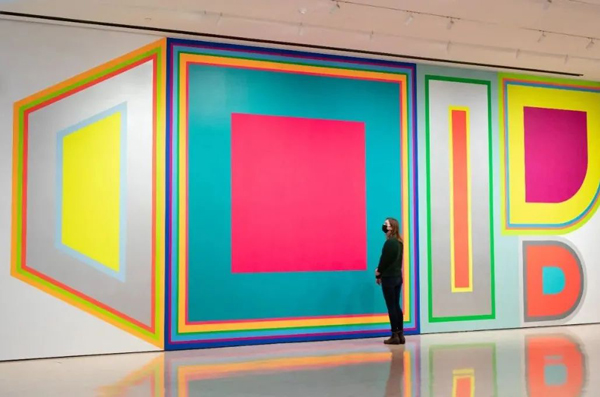
Beverly Fishman: Recovery I, installation view at the Eli and Edythe Broad Art Museum at Michigan State University, 2022. Photo: Eat Pomegranate Photography. Courtesy of Beverly Fishman
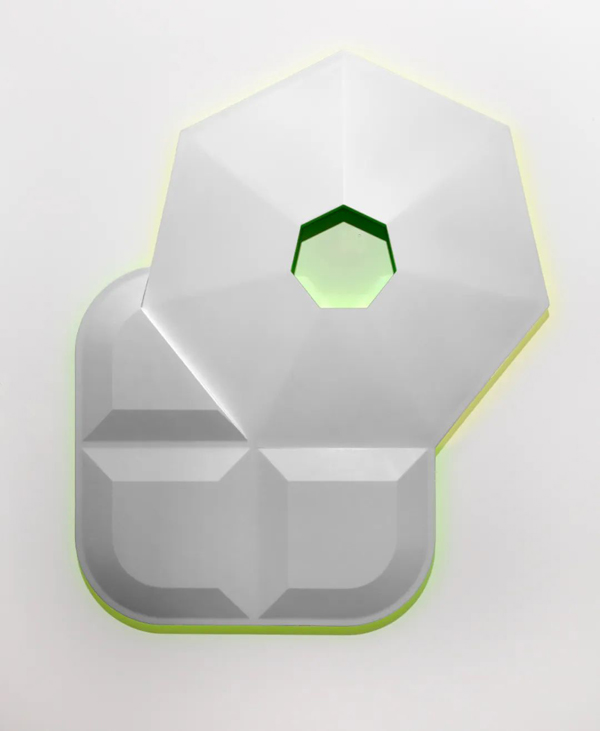
Beverly Fishman, Untitled (Depression, Opioid Addiction), 2020. Urethane paint on wood. 43 x 36 in (109.2 x 91.4 cm). Photo: PD Rearick. Courtesy of Beverly Fishman
Hu Lingyuan: Color has always been a visible presence in your work. How do you make your choices and combinations of colors? Do you consider color in relation to the theme of this exhibition, "Recovery," as you did with the two works in this exhibition?
Beverly Fishman: I am always looking to surprise myself—to come up with combinations that look surprising, that I didn’t expect. I also like working with colors that you don’t traditionally see in modernist painting—neons and pastels, for example. Sometimes I explore mixing natural and non-natural colors. In the past six years, I’ve been painting with colors that I associate with makeup and the construction of femininity. Color is always very material to me because I don’t just see it and sometimes I taste it or hear it. I am also very aware of color’s beauty and seductive nature. Pharmaceutical companies research and employ color as a means of enhancing their medicine’s marketability and effects. I want to seduce you with color, but also make you feel slightly uneasy.
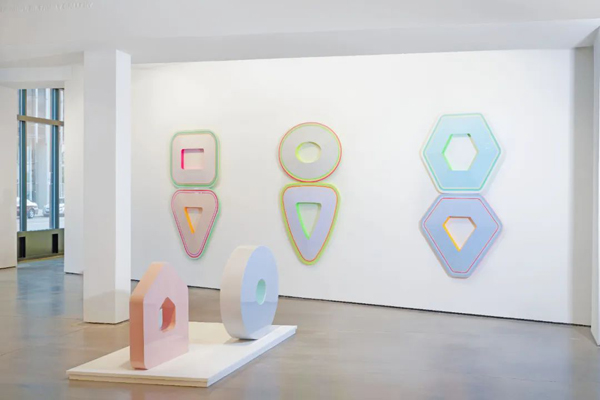
Beverly Fishman, CURE, installation view, The Contemporary Dayton, Dayton, OH, 2022. Courtesy of Beverly Fishman
Hu Lingyuan: When I came across your works, I felt as if I dropped into a sweet and dizzying world. I didn't immediately realize what they might represent, but I believe it was not just a reading of the abstract language. So, what made you interested in the pharmaceutical industry?
Beverly Fishman: I have always been fascinated by doctors and medicine. I watch tons of medical reality shows that reveal the split-second decision making process of emergency rooms, for example. I am also inspired by medical researchers who are looking for cures to deadly diseases. Their creativity when looking for a cure rivals that of artists. In my art, I have always been very concerned with questions of identity. Early on, I was interested in gender and feminism and how one’s identity was defined by one’s x and y chromosomes. Then the AIDs crisis affected me deeply. I became aware of how disease constrained identity, how you became defined by the virus that you contracted.
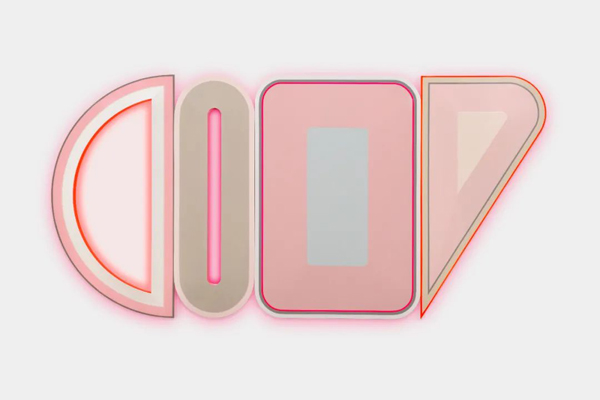
Beverly Fishman, Untitled (Pain, Bipolar Disorder, Sleepiness, Migraine), 2021. Urethane paint on wood. 44 x 88 x 2 inches. Photo: PD Rearick. Courtesy of Beverly Fishman
Beverly Fishman: I also had family members who were sick. Over the years, I have been very affected by their struggles to regain their health, and the role that medicine played in making them better. As a result, around 1999, I turned from an examination of the body and disease to an exploration of the cure. That’s when I started using the shapes of pills and pharmaceuticals. I think of those shapes as abstract icons—forms that embody our ideals of health and beauty, as well as our fears of bodily and mental decline.
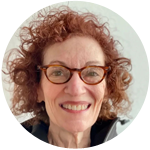
Beverly Fishman is an artist who adopts the language of abstraction to explore the body, issues of identity, and contemporary culture. Her career-long investigation draws upon medical imaging, pharmaceutical design, and the history of modernist painting. She is the recipient of many awards, including the National Academy of Design Academician Award; an Anonymous was a Woman Award; the Hassam, Speicher, Betts, and Symons Purchase Award from the American Academy of Arts and Letters; a John Simon Guggenheim Memorial Foundation Fellowship; a Louis Comfort Tiffany Foundation Award; an Artist Space Exhibition Grant; and an NEA Fellowship Grant.
Fishman’s work has been the subject of over forty solo exhibitions at galleries in New York, London, Paris, Berlin, Thessaloniki, Chicago, St. Louis, Los Angeles, and Detroit. It has also been shown at the Chrysler Museum, the Detroit Institute of Arts, the Toledo Museum of Art, and the Columbus Museum of Art. Her work is represented in many collections including the Eli and Edythe Broad Art Museum at Michigan State University; the Mint Museum; the Cranbrook Art Museum; the Nerman Museum of Contemporary Art; the Maxine and Stuart Frankel Foundation for Art, the Pizzuti Collection. Her work has been reviewed in numerous art magazines, newspapers, and scholarly publications, including The New York Times, The Brooklyn Rail, Artforum, Huffington Post, Modern Painters, Artnet Magazine, Wallpaper, NY Arts Magazine, The Wall Street Journal, and Art in America. Between 1992 and 2019, she was Artist-in-Residence and Head of Painting at Cranbrook Academy of Art in Michigan. She is represented by Miles McEnery Gallery, New York, NY; Kavi Gupta Gallery, Chicago, IL; and Library Street Collective, Detroit, MI.


